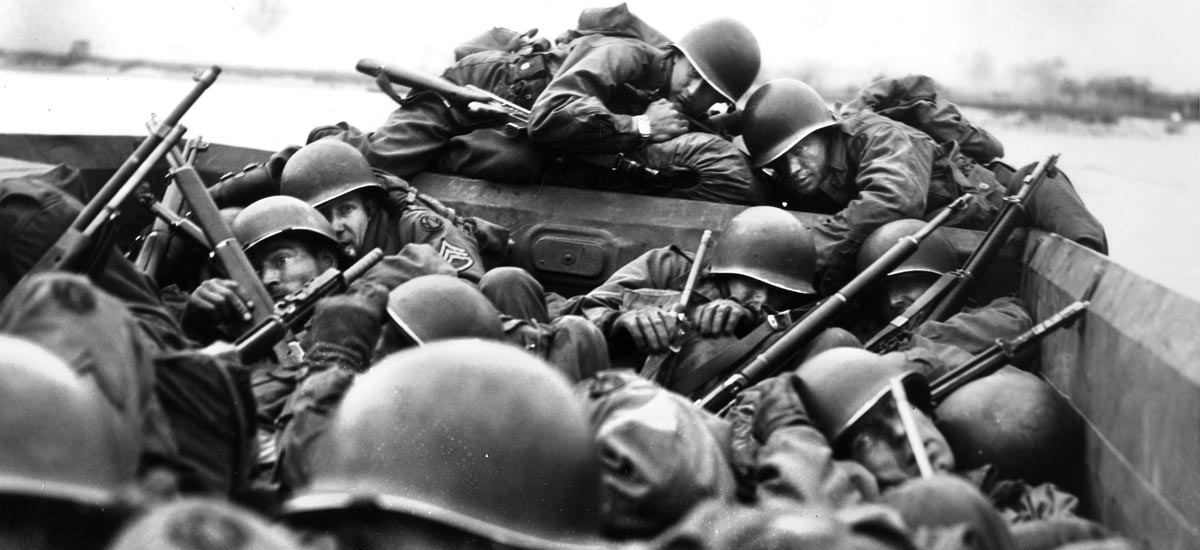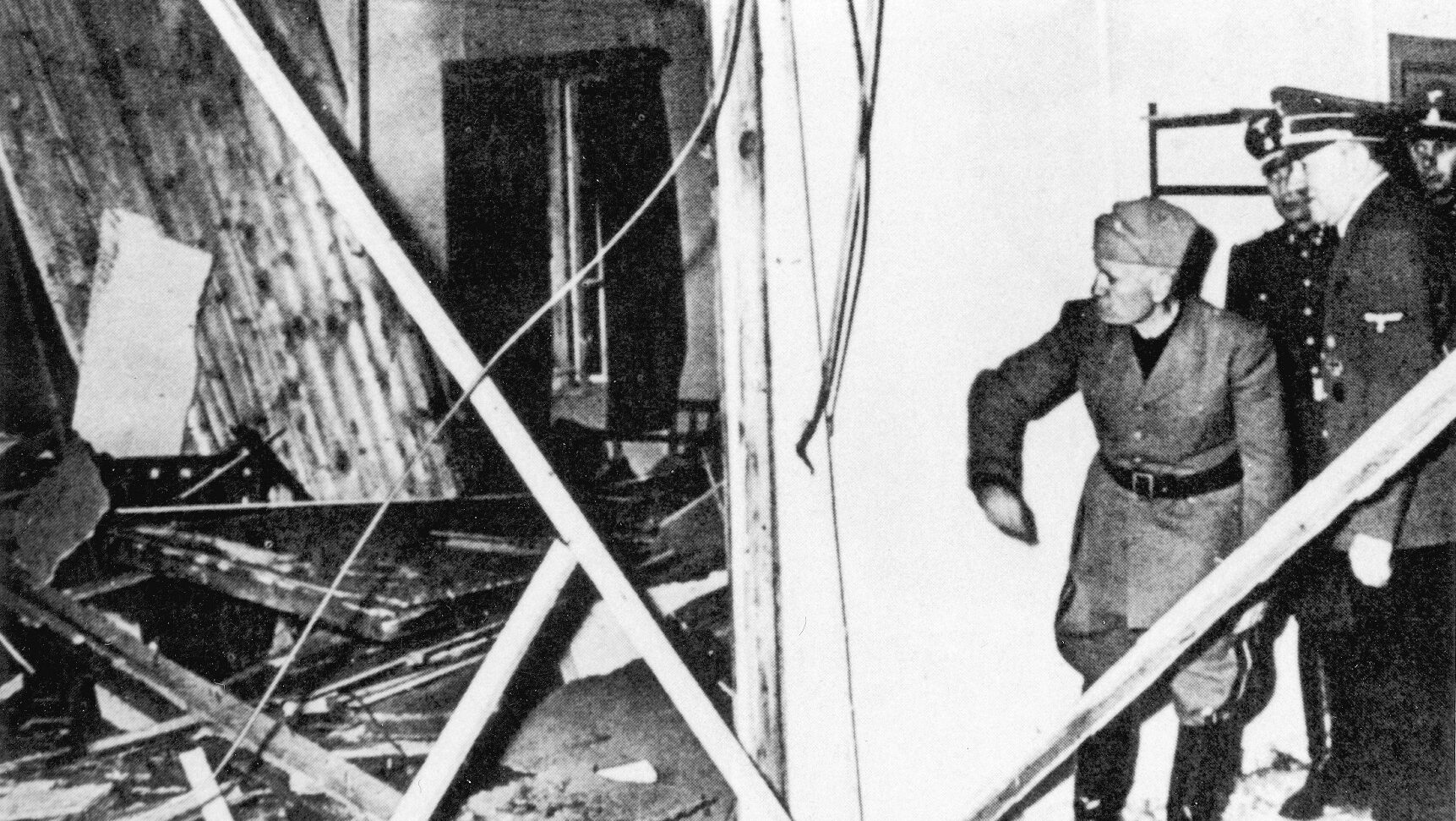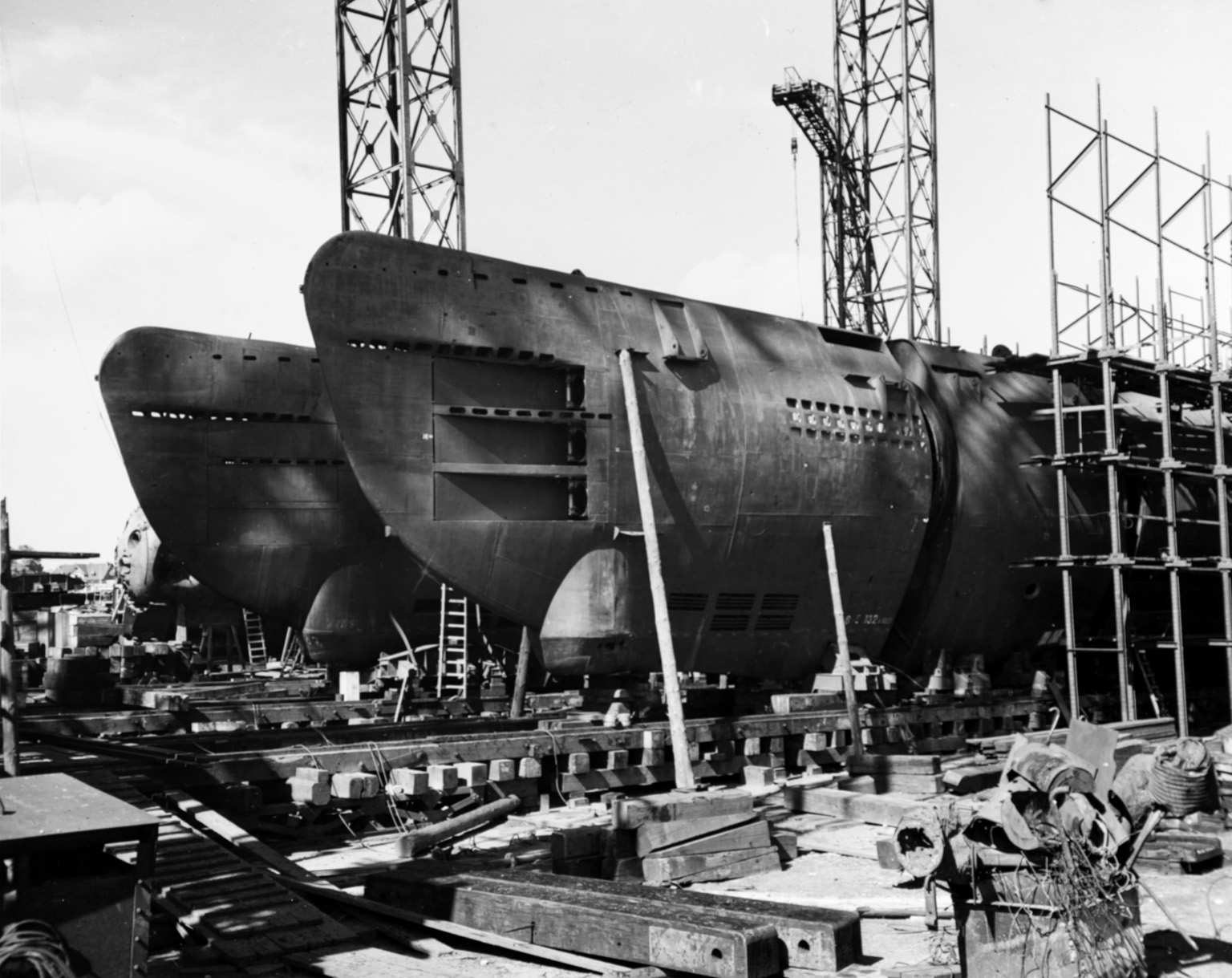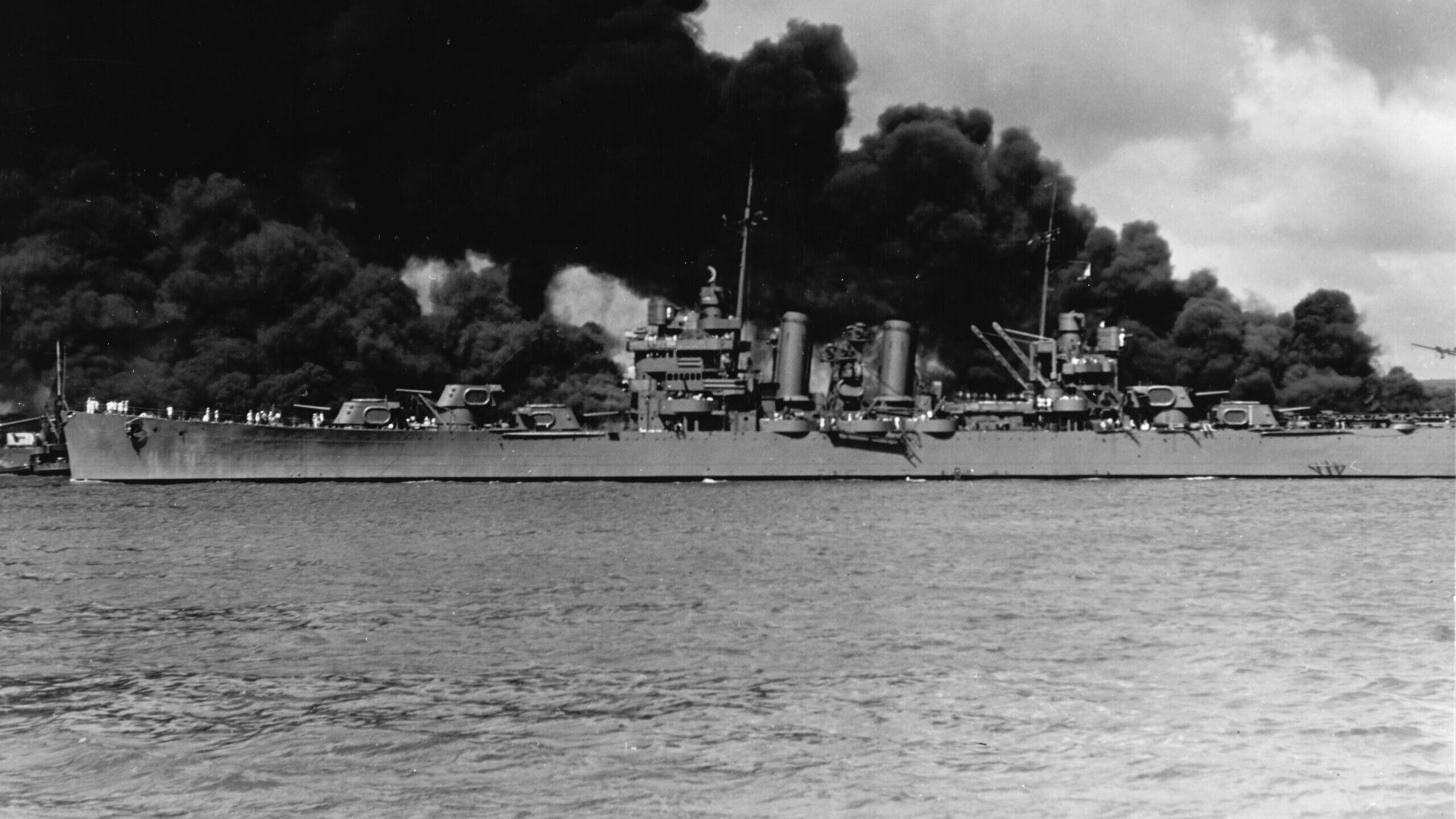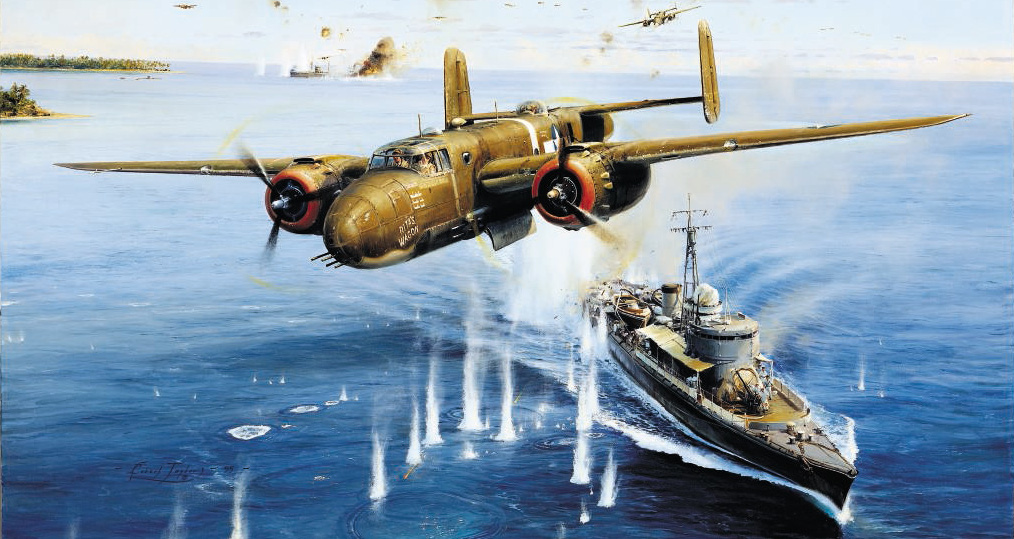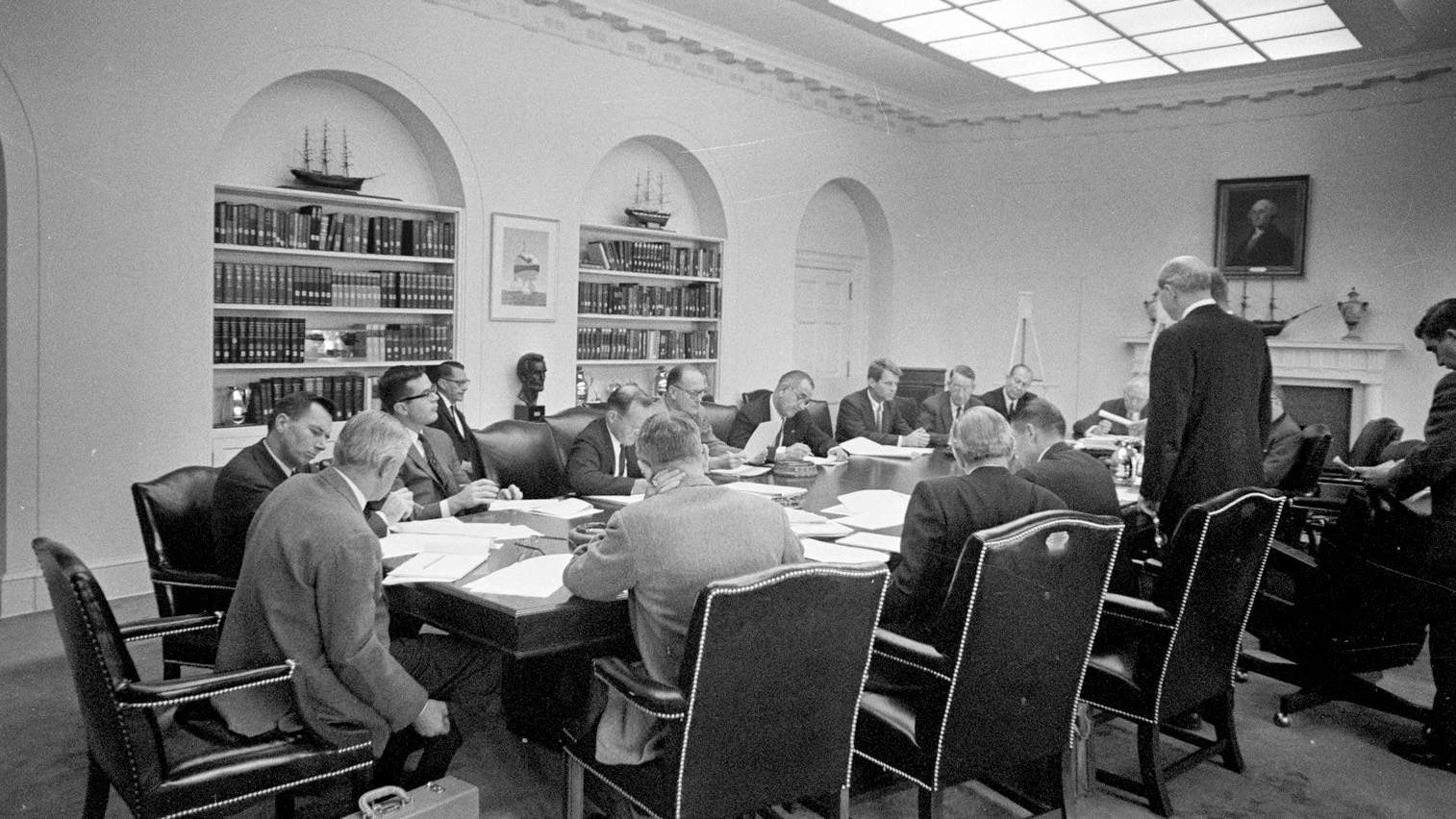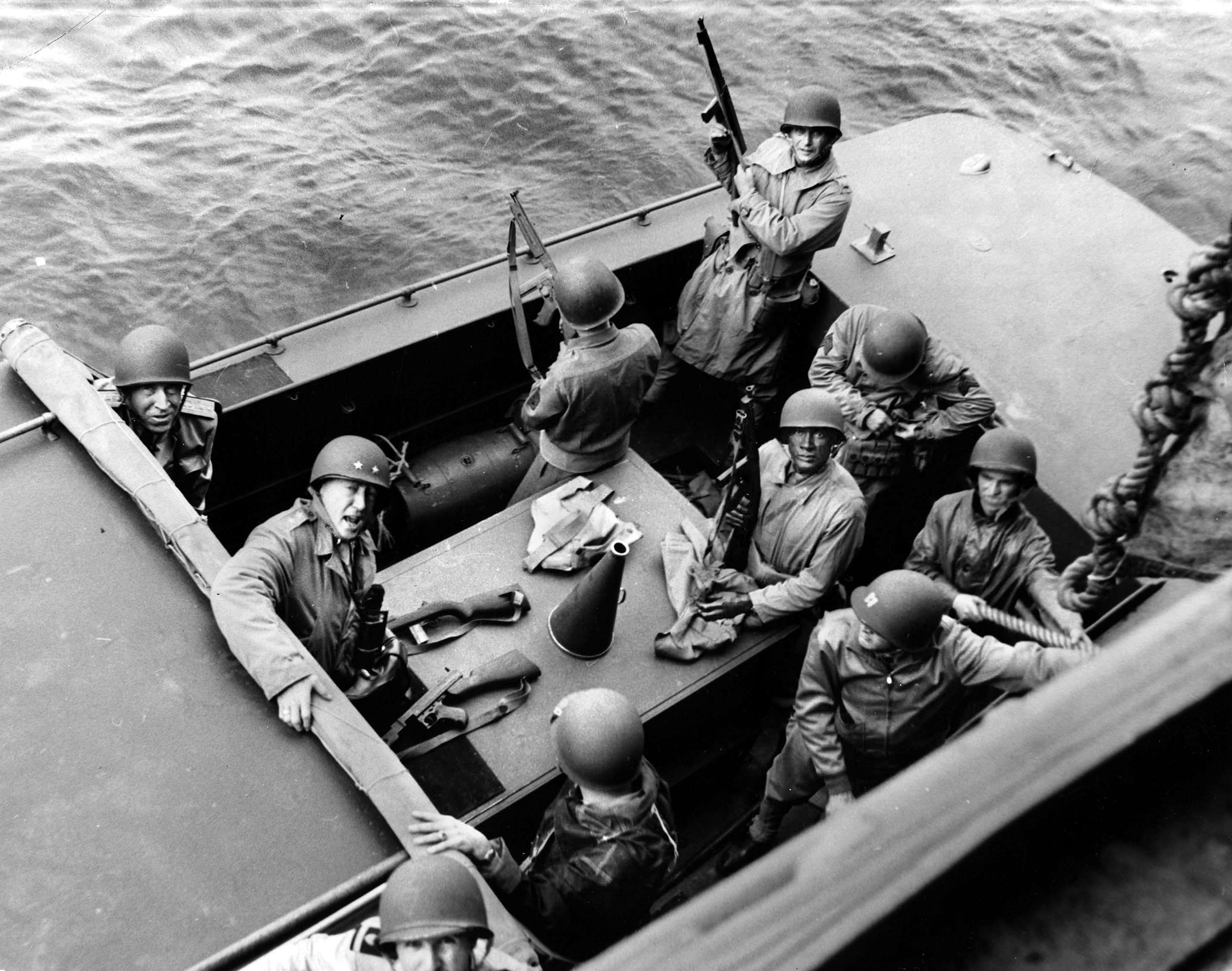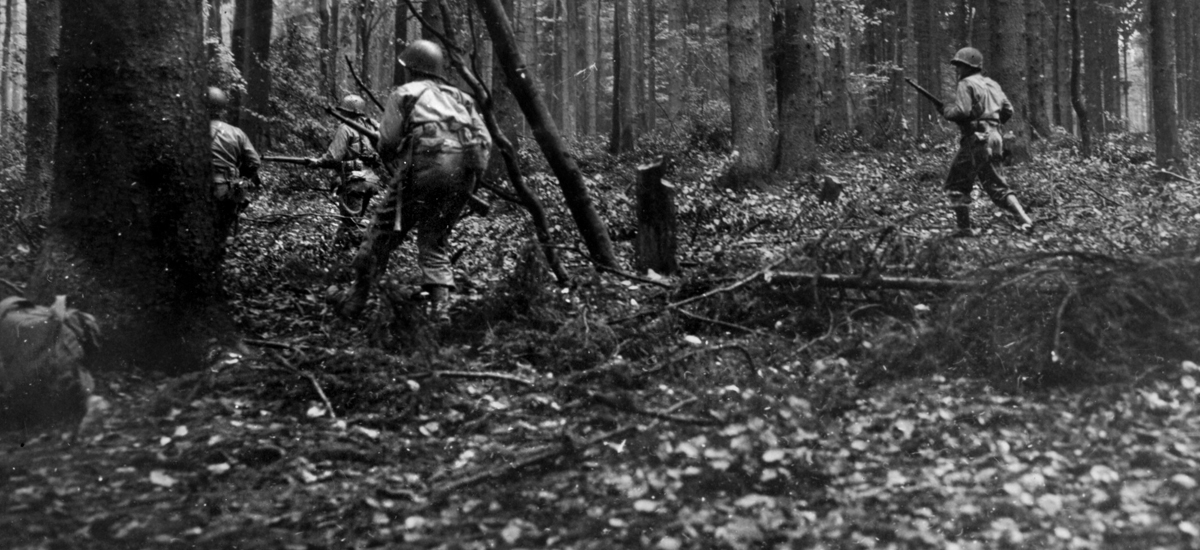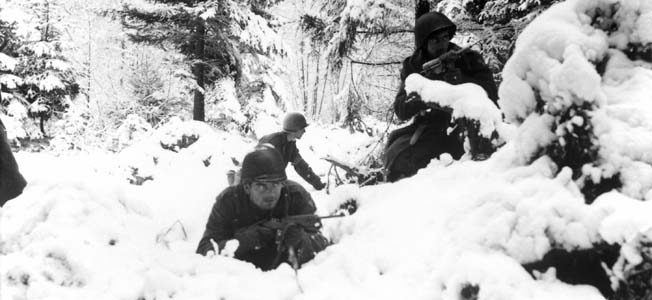By Brig. Gen. (USA, Ret.) Raymond E. Bell, Jr
The American Ninth Army’s crossing the Rhine River on March 7, 1945, in the early days of the Battle of Remagen is a well-known chapter of military history. At least one book and one Hollywood movie, along with numerous magazine articles and websites, have detailed the subject. But the story of the boat units that took American soldiers across Germany’s last natural barrier has rarely been told—until now. (Read more in-depth stories of the Second World War, from the notorious to the lesser-known, by subscribing to WWII History magazine.)
On March 22, 1945, Lt. Gen. George S. Patton, Jr.’s U.S. Third Army made a surprise hasty crossing of the German Rhine River in the vicinity of Oppenheim at the village of Nierstein. The assault was conducted without prior artillery or air preparation and without any formal plan. It was made in moonlit waters “on the run” by the fast-moving divisions of Maj. Gen. Manton S. Eddy’s XII Corps.
The lead unit across was Company K, 5th Infantry Division, 11th Infantry Regiment, Third Battalion. Immediately after that division’s successful passage, 90th Infantry Division troops swept across the river, followed by the tanks of the 4th Armored Division.
The crossing was another of Patton’s successful exploitations of the crumbling German homeland defenses. And it was made with great assistance from the U.S. Navy and Coast Guard.
The Story of the LCVP
Among the naval participants was Seaman First Class Richard Michael Birkler, U.S. Naval Reserve. Birkler served as the coxswain of a Landing Craft, Mechanized, or LCM, which was popularly known as a “Mike” boat. It was one of the creations of Andrew Jackson Higgins, who had conceived and built the famous “Higgins boat” landing craft officially known as the Landing Craft, Vehicle Personnel (LCVP). Along with the LCVP, the LCM was built by the thousands and was employed globally in World War II.
The Mike boat, an all-metal vessel that displaced 30 tons, was developed to carry a single armored fighting vehicle the size of a Sherman tank. Some times called a “tank lighter,” it had twin diesel engines that made it quite maneuverable and therefore required a skilled coxswain such as Birkler to “drive” it. The craft’s 130-mile range also meant that it could sail across the English Channel on its own.
The LCM’s little brother was the LCVP. It had a longer history than the LCM, having evolved from the initial Higgins boat called the Landing Craft, Personnel (LCP). The LCP was a flat-bottomed vessel, 36 feet long, made of plywood, and it had a bow in the shape of spoon, which allowed it to swim up on a gradually sloping beach. This characteristic, along with the shallow draft and flat bottom, was exploited in the development of the LCVP, which could carry 36 men and a crew of three. The LCVP’s 36-foot length and 10-foot width also allowed it to carry a two-and-a-half-ton truck or two quarter-ton jeeps after a bow ramp was added, which allowed the vehicles to drive off the vessel.
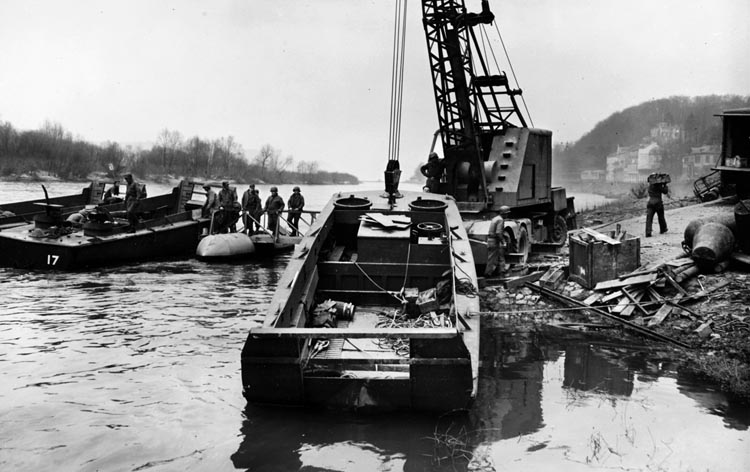
Both the LCM and LCVP were participants in the Rhine River crossing. They were “driven” by U.S. Navy sailors and Coast Guardsmen, many of whom had served on such boats in the June 1944 invasion of Normandy. The crews were members of the Navy’s Task Force 122.5, which was composed of five subordinate task units initially equipped with the LCVP. When it was realized that craft capable of carrying armored fighting vehicles would be required, LCMs were added to the task units.
Each unit had a complement of boat crews and a maintenance detachment. One unit each was assigned to the First, Third, and Ninth U.S. Armies as task units (TU) and designated as TU 122.5.1, TU 122.5.2, and TU 122.5.3, respectively.
The commanders of these task units were U.S. Naval Reserve officers, Lieutenant Wilton Wenker, Lt. Cmdr. William Leide, and Lt. Cmdr. Willard T. Patrick. A fourth task unit (TU 122.5.4) was organized under Reserve Lieutenant (j.g.) Thomas Reilly and stationed at the French port of Le Havre where it could serve as a backup to the three forward-deployed TUs. (The fifth TU was assembled in the British Isles and did not deploy to the Continent.)
Each unit was composed of 24 “boats” (as they were called in the Navy), 13 officers (most of very junior grades), and 205 men, either U.S. Navy or U.S. Coast Guard. Task Group 122.5, to which the boats were assigned, was commanded by U.S. Navy Commander William J. Whiteside. Because of the decentralized nature of the various river-crossing operations, he exercised limited command and control over the task units.
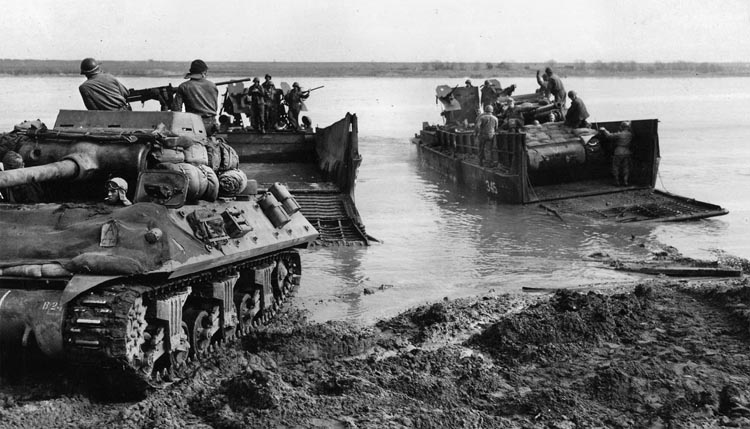
Failure at Arnhem: Why Crossing the Line took Months of Preparation
Preparations for an assault over the Rhine began well before the first successful crossing from the German town of Remagen on March 7, 1945. Had the British succeeded in crossing the river in early September 1944 at Arnhem in the Netherlands, the U.S. Navy may never have had to provide assistance in the Rhine River effort.
The failure to defeat the Germans defending the bridge over the river at Arnhem, therefore, helped precipitate the employment of LCVPs and LCMs in the crossing by the British and the American First, Third, and Ninth Armies in March 1945.
In anticipation of the destruction of all bridges over the Rhine River, and recognizing that the river with its great width and swiftly flowing current posed a major obstacle to its crossing in early October 1944, Lt. Gen. Omar Bradley’s engineers went to the commander of U.S. Navy forces in Europe, Admiral Harold Stark, to inquire about possible Navy assistance.
The result was the decision to deploy LCVPs and LCMs with their ability to operate the best in the Rhine’s challenging eight-knot current. Planning conferences began that same month.
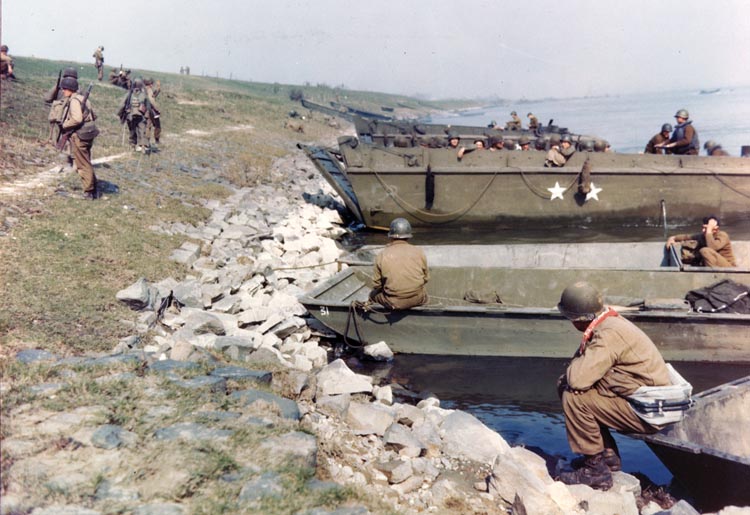
In the early autumn of 1944, there was a stalemate across the entire battlefront in northwestern Europe after the failure of Operation Market Garden with little prospect of an immediate drive to cross the Rhine. This gave the Navy the opportunity to step in and join with Army engineers in training for deliberate river crossings using both Army and Navy assets. By November 1944, Army and Navy planners reached a general outline for the Rhine crossings.
Certain Army engineer units positioned in the rear areas took up the task of training and experimenting with not only their own equipment but with the employment of Navy boats. For the Navy, training began with the shipping of the LCVPs on British ships to the French port of Le Havre, where the boats of TU 122.5.4 remained as the command reserve. The LCVPs to support the three U.S. armies were placed on trucks with trailers and dispatched to selected engineer locations on rivers in Belgium and France where required pre-crossing training could be conducted.
The first LCVP boat unit to reach the European continent was Wenker’s TU 122.5.1. It arrived in Belgium on October 18 and was attached to the 1120th Combat Engineer Group of First Army’s VII Corps. Within a week, six of the boats were moved from the group’s location at Andenne on the Meuse River in Belgium to a training site with the 298th Engineer Combat Battalion at the village of Cheratte. The site offered a river purportedly similar to the Rhine River. One week later, another site was opened at Liege with the 297th Engineer Combat Battalion.
Just moving the boats to the various rear areas turned out to be a training exercise as routes to accommodate the loaded vehicles had to be carefully selected. Buildings sometimes had to be demolished in rubble-filled villages and towns to allow passage of the oversized vehicles.
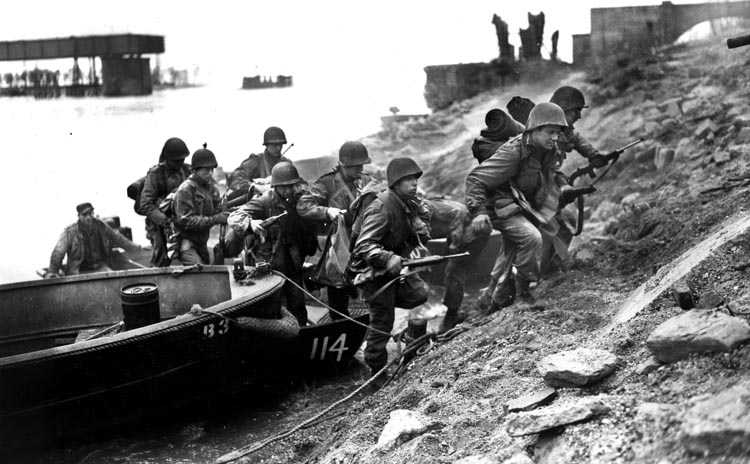
When the LCMs sailed across the English Channel in January 1945, they were loaded on tank-retriever trailers that, along with the tractors, were 77 feet long and weighed 70 tons. Through careful handling, the boats reached their destinations safely and the lessons learned in transporting the vessels over land were put to good use later when they were required on short notice to be taken to launching sites on the Rhine.
On-site training for Wenker’s Task Unit 122.5.1 resumed at Andenne after experimentation with different LCVP launching methods was brought to a successful conclusion at Cheratte. Because the Army engineers were to control the boat operations, half a week’s training was with Army engineers. The boats worked on assisting the engineers in the building of various bridges, prototypes for those that might be built over the Rhine.
The remaining week was spent in conducting Navy training and maintenance of the boats. The training was intermittent but intensive, as First Army’s plans changed, first with a possible crossing of the Roer River, which was cancelled, and then the German Ardennes offensive (the Battle of the Bulge) in December. In the latter case, the Germans came within 11 miles of Andenne, and it became necessary to move the crews and boats farther back into Belgium to Waremme to avoid their capture or destruction.
Leide’s Task Unit 122.5.2’s experience for the cross-river assault is demonstrative of the preparation activities conducted by the boat units. The unit was attached to the U.S. Army’s 1134th Combat Engineer Group located in the vicinity of Toul, France, on the Moselle River for training and experimentation purposes. It was billeted in a former cavalry barracks that had been occupied by the German Army and was close to the river where the launching and retrieving of the boats could be practiced.
Why the December Launch Date was Pushed Back
On November 15, 1944, the boat unit reached Toul and prepared for a scheduled December crossing of the Rhine River. The boat crews began intensive training that was conducted day and night under disagreeable weather conditions (cold with continuous rain, sleet, and mist). The Moselle had recently been at flood stage, which caused some problems, but otherwise provided no real challenge as its normal width hardly matched what was to be encountered on the Rhine.
In addition to the repetitive training, the boat unit performed many and diverse experiments in loading and transit. Unit members attempted different techniques for loading and securing every type of weapons system that would fit in an LCVP. For the purposes of evacuating wounded, a kit was developed to allow for the litter transport of 14 prone casualties. Different techniques were experimented with for carrying various types of small, wheeled vehicles and it was found, for example, that a nine-and-a-half-ton bulldozer could be barely fit into a LCVP’s hull. All the work, however, was done with the LCVP, as the LCMs would not be available for the anticipated December crossing.
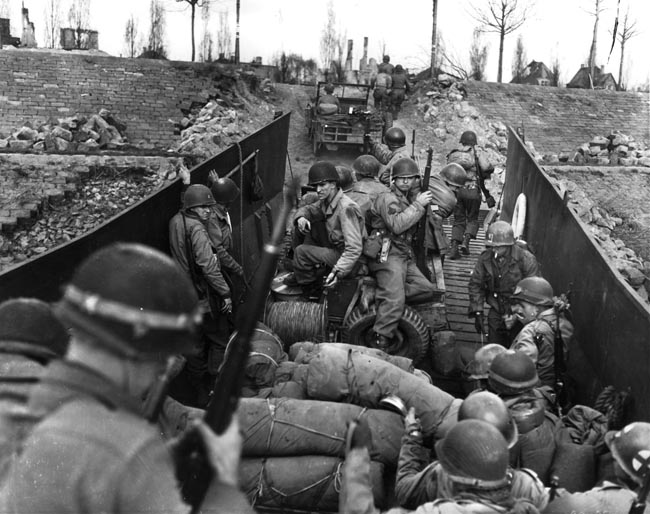
On December 10, Leide and his key personnel attended a river assault briefing at Third Army Headquarters in Nancy, France. The Army had just launched a crossing of the Saar River in Germany with the plan to penetrate the German West Wall and advance on the Rhine River.
Hopes were high but turned out to be premature, because on December 16 the German Army launched its Ardennes offensive. Boat training was turned to practicing demolition of the vessels with thermite grenades if the offensive reached the boats’ locations.
Wenker’s boats at Andenne on the Meuse River in Belgium were the most threatened as they were in the path of the German thrust toward Antwerp. Those of Leide and Patrick, located out of the intended path of the German advance, were not so nearly in danger of being overrun, but destruction preparations were made just in case.
As the German attack faltered, 45 LCMs arrived on the Continent for transporting heavier vehicles and equipment over the Rhine River. With the boats came additional personnel to include, for Third Army, a detachment of Seabees (members of a Naval Construction Battalion), who were to instruct Army engineers in the assembly of light-range pontoons. Leide’s boat unit grew to include 250 enlisted men and 18 officers. The other boat units received similar increases in strength.
With the reduction of the so-called Bulge and the retreat of the German Army back into Germany, the time for a Rhine River assault crossing approached. On March 7, elements of the U.S. Army’s 9th Armored Division seized the Ludendorff railroad bridge over the Rhine at Remagen. Wenker’s task unit in the First Army sector was the first to see action.
The Start of the Battle of Remagen
The training in boat operations and overland movement proved its worth when, on the night of March 7, 1945, Wenker got a hurried call informing him that the U.S. 9th Armored Division had captured a bridge intact at Remagen on the Rhine. This was a revelation, for the Germans had blown all the other bridges behind them as they escaped farther to the east. Wenker was ordered to move his boats to the crossing site as soon as possible. The Battle of Remagen was now underway.
Loading his LCVPs and LCMs onto their tractor-trailer combinations, Wenker moved his Boat Unit 1 over narrow and congested roads. Avoiding bottlenecks wherever possible, his behemoths had to compete with troop units, armor formations, and supplies for road space. Official reports described the trip as being “nightmarish.” But on March 11, his sailors and Coast Guardsmen launched the first 10 of their boats into the Rhine at the riverside town of Bad Neuenahr.
Operating now under the control of First Army’s III Corps, the first boats were assigned to assist the 552th Engineer Combat Battalion in constructing a heavy pontoon bridge over the Rhine at Quip. The intensive preparatory training began to pay off.
In the first week of the Battle of Remagen, while the Ludendorff Bridge was still capable of supporting troops and heavy equipment, the boats worked continuously, often under fire, in helping build six additional bridges and protect them from enemy suicide swimmers. They did yeoman’s work in supporting the engineers with their ability to operate in the swift Rhine River current that challenged Army water equipment.
By March 15, all 24 of the LCVPs were in action, operating on a 35-mile front. When the weakened railroad bridge at Remagen finally collapsed, the unit turned to transporting troops of the 1st, 2nd, and 69th Infantry Divisions across the river while bringing back several hundred wounded. By March 27, 14,000 troops and 400 vehicles had been ferried to the east side of the Rhine.
Patton’s Third Army had raced to the Rhine River at multiple points before it began to cross early on March 22. In all four points, Third Army units made four assaults across the river. The first, on March 22, was at Nierstein, a short distance from Oppenheim, by the 5th Infantry Division and was followed closely by the 90th Infantry Division.
The second assault crossing was made by the 87th Infantry Division, down the river at Boppard, on the morning of March 24, which was followed the next night at St. Goar a few miles upriver from Boppard. The last crossing was from the city of Mainz at the confluence of the Rhine and Main Rivers on March 28 by the 80th Infantry Division. All the landings were supported by Leide’s task unit using LCVPs and LCMs.
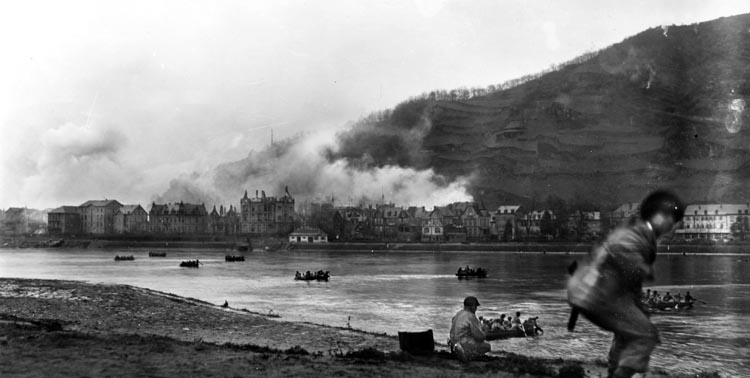
Although training with the Army’s 1134th Combat Engineer Group had proceeded well, Leide found the Army units at the various sites were vague as to how and when to employ the boats when it came to actually executing crossing missions.
Leide had to assert himself several times to get the Army units to even consider utilizing the Navy elements. It did not take long, however, for the boats to prove their worth, as statistics revealed, and it resulted in an emphatic letter of commendation from Patton after the crossings.
Patton Races Montgomery
Once Patton decided to beat his rival, British Field Marshal Bernard Montgomery, across the Rhine, events moved fast. On March 21, Leide and his executive officer were on their way to coordinate the crossing at the town of Worrstadt about 20 miles from Oppenheim when Army headquarters told them the jump-off time was slated for 10 pm that evening. Leide had not even had an opportunity to make a reconnaissance of possible launching sites, which complicated where along the river to bring the boats for entering the water.
As it was, the LCVPs, which had left Toul earlier, arrived on their tractor-trailers at 9:30 to find that the 11th Infantry Regiment was to make the initial assault in Army engineer craft. The sailors found the combat troops unsure as to how to use the LCVPs and could not decide at first how many they wanted Leide to deploy. On his own initiative, Leide chose to unload his boats using Tournau cranes from the Army vehicles and launch them into the water at Nierstein.
By five o’clock in the morning of March 22, Leide had his boats in the water and performing various tasks. The Rhine at Nierstein at the time was approximately 800 feet wide, with a slow current of about two and a half miles an hour, with an estimated depth of 10 feet. The conditions there favored the use of the LCVPs, three of which began to help Army engineers build bridges and lay booms and nets.
Once the method for deploying boats as troop transports was sorted out by the Army, activity quickly accelerated. In 48 hours, the LCVPs carried more than 15,000 troops across the river. The boats managed to ferry troops across the river and bring back German prisoners-of-war and casualties within a turnaround time per trip of six to eight minutes. All this work was done under sporadic German artillery and small-arms fire as well as an occasional air attack, but the Navy suffered no casualties.
The next assault crossing was made in the VIII Corps sector at Boppard with the 87th Infantry Division, in which six LCVPs from Oppenheim were designated to participate. Leide wanted to launch the boats during early morning darkness on March 26 to protect them from German artillery fire, but he was overruled, and the crossing began in daylight, fortunately without loss of boats or personnel. Every hour, the landing craft, each carrying 36 men, made nine round trips resulting in 5,000 men and 400 vehicles being ferried across.
The afternoon of March 26 saw six LCVPs again in action with the 89th Infantry Division’s crossing at Oberwesel. The initial transit was made in unprotected DUKWs (Army amphibious trucks) and proved to be very costly in infantrymen losses. The division, having failed to establish a bridgehead, turned to the Navy and this time, along with the LCMs, took over the operation. Within 48 hours the entire 89th—with all its vehicles and equipment—was carried across the Rhine without suffering casualties. The Navy made its point but at a high price for the foot soldiers who were in the first waves.
The last river crossing was made on short notice opposite the city of Mainz early on March 28 by the XX Corps’ 80th Infantry Division with a dozen LCVPs and six LCMs. The 80th tried what the 89th had attempted and was also initially unsuccessful. The first assault wave in 20 Army assault craft at 1 am was virtually wiped out. Later, at 3:30 in the morning, the Army officer in charge suspended the crossing operation due to heavy enemy fire.
Naval Reserve Ensign Oscar Miller, however, did not get the suspension word. He launched the first LCVP across the river that was to land some 500 yards below the planned line of departure. It met with no enemy resistance, and the other boats were then launched, all with no casualties.
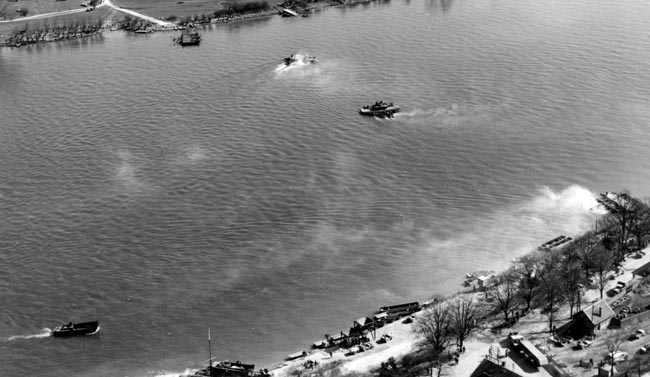
In three hours, 3,500 men successfully made the crossing, but at 7 am, German artillery found its mark on the launching site, scoring a direct hit on a bulldozer, demolishing several trucks on the launch pad, and killing Navy Lieutenant (j.g.) Vincent Avallone, the Navy’s only fatality during the entire operation.
Still, work went on unabated with the boat crews and support personnel working six-hour shifts for three continuous days without respite.
A Concerted Allied Effort
For its performance in supporting the Third Army’s four Rhine River crossings, Leide’s boat unit drew special praise from Patton. In an April 23 letter of commendation, Patton cited the transport of thousands of soldiers and vehicles in such a manner as to draw the appreciation and admiration of his army for the unit’s participation.
While the Third Army’s river crossings were made on the run, those by Lt. Gen. William Simpson’s Ninth Army reflected the character of British Field Marshal Montgomery, under whose command Simpson was to cross the Rhine. Montgomery called for a detailed and elaborate plan, which stipulated exact times for nighttime transits at specific times by Army assault boats and Navy LCVPs that would commence after a two-hour artillery fire preparation. Ninth Army’s 30th and 79th Infantry Divisions were to cross on either side of the small Rhine River town of Rheinberg.
Supporting the assault was Patrick‘s task unit with its allocated LCVPs and 24 LCMs. After the first assault waves were ferried in Army assault boats, the landing craft followed. Initially, there was trouble unloading the boats from the tractor-trailers in the dark on rough terrain while under German artillery fire.
A crane also dropped the first LCVP to be unloaded, which augured poorly for launching the remainder of the boats, but by 9:30 am, five other LCVPs had taken to the river. The LCMs had to be pushed into the water bow first, which was accomplished without damaging their propellers.
On D-day, Patrick’s boat unit ferried 3,000 troops, 374 tanks and tank destroyers, 15 bulldozers, 80 57mm antitank guns, and 500 jeeps and other vehicles across the Rhine. On the return trips 200 casualties were evacuated along with 500 prisoners of war.
One LCM had the dubious honor of ferrying British Prime Minister Winston Churchill, Field Marshals Montgomery and Alan Brooke, and General Simpson about on the Rhine for half an hour with the only notable contribution of each of the high-ranking individuals being to relieve themselves in the river.
Seaman First Class Richard Birkler, the coxswain on a U.S. Navy LCM of TU 122.5.2, was one of the many unheralded sailors and Coast Guardsmen who manned the boats that transported thousands of American soldiers, weapons, and tons of equipment across the Rhine in March 1945. Their contributions have largely gone into the history of World War II as a minor footnote.
Yet, without their invaluable contribution, there would not have been the many successes the U.S. Army had in moving so many of its forces across the very wide and fast-moving obstacle that the Rhine River presented.
